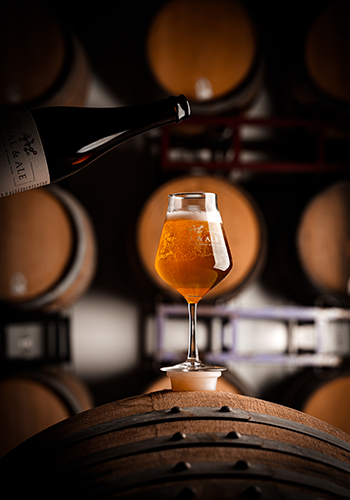A search for microbial bugs in beer points to opportunities for students
Seth Krahn has open-ended career ambitions.“I guess I’d like to be a laboratory gremlin,” says the 24-year-old, soon-to-graduate Biological Sciences Technology Laboratory Research and Biotechnology student.
That is, he wants to be a researcher who works with microbes and molecules. What exactly he might do with them doesn’t worry him. His experiences so far have shown him what he’s learned can be put to many uses – including in the world of craft beer.
This year, Krahn was part of the first lab research and biotech class in which all of the final student research projects were carried out for partners outside of NAIT.
Two groups, for example, worked with a local composting company to analyze its liquid fertilizer and other products for beneficial compounds and microbes. Another worked with a University of Alberta lab to search for a gene that can help predict human stress levels. In another U of A partnership, NAIT students contributed to a study of genes related to diabetes.
In Krahn’s case – along with classmates Monisha Chand, Aidan Dion, Dinky Goyal and Kelsie Hewko – the partner was Trial and Ale, an Edmonton brewer of wild and sour ales that presented a challenge that would add a skill set to the job description of “gremlin” that no student could have expected.
A study of a “dirty” brewery

Krahn gravitated to working with Trial and Ale partly because of a family hobby. His dad is a veteran of home wine making. Krahn himself once made his own ginger beer using baker’s yeast. “It went terribly," he says, "but it was fun.”
Working with the local small brewery, which launched its first beer in July 2020, intrigued Krahn for another reason, too. A major-brand lager, he points out, is stringently fermented using one microorganism, a strain of brewer’s yeast. This ensures consistent quality and flavour.
Should a rogue yeast or bacteria interfere, “It’s chaos and anarchy as they try to contain it,” says Krahn.
With Trial and Ale, he adds, that’s not so much the case.
Co-owner Ryan (who asks that his last name be private) is more frank about the matter. “We’re a ‘dirty’ brewery, but we’re a dirty brewery with some segregation of microbes,” he says.
Trial and Ale does not appear outwardly “dirty.” Located in a west-end business park, it’s a cavernous space housing dozens of 225-litre French oak barrels racked on their sides three high and in neat rows. Bags of grain are tidily stacked on pallets. A humidifier on a wall emits bursts of mist. The floors aren’t quite clean enough to drink off of, but close.
The floors aren’t quite clean enough to drink off of, but close.
Inside those barrels it’s a different story – which is the reason for the partnership with NAIT, brokered by bio sci tech instructor and beer enthusiast Jim Wickware. Rather than relying on a single strain of yeast, Trial and Ale ferments using a “slurry” containing a variety of yeast and bacteria. And the oak itself harbours microbes from previous batches, as the barrels are used repeatedly.
Each bug contributes unique flavours as it metabolizes sugars and other compounds in the liquid over the course of roughly a year, and sometimes longer.
Over that time, the microbial population changes, and so does the beer’s flavour.
“We want our vessels to be the zoo,” says Ryan. “We put our animals in the zoo in proper proportions and let them fight to the death.”
While that sounds like the worst zoo ever, the approach has led to award-winning beers that are sold in Canada, the U.S. and the U.K. The catch is that Ryan doesn’t know exactly which microbes win out to make “mixed-fermentation” brews that varyingly taste bright and tart, or complex and funky, or that can be aged with fruit.
“We have a pretty good idea about the microbes we have in there, based on sensory [tests],” he says. “But we don’t pretend to know what we don’t know. There are things that are happening in our barrels that we’d like to understand better.
“The understanding we’ll leave to the experts.” Or in this case, experts in the making.
Mysteries of “west-end terroir” revealed
 This spring, Krahn and his classmates drew samples from a selection of barrels, plated them on petri dishes and identified the beer bugs that grew.
This spring, Krahn and his classmates drew samples from a selection of barrels, plated them on petri dishes and identified the beer bugs that grew.
In some cases, they confirmed the presence of the likes of Lactobacillus and Pediococcus, which contribute various sour flavours to the beer, as expected. In other cases, they found them in barrels where they were not expected.
To Ryan’s surprise, the students also showed the possibility that Brettanomyces, a wild yeast often responsible for the pungency of barrel-aged mixed-fermentation beers, to be present in lower quantities than anticipated.
“In the end, they made some very interesting discoveries and I believe provided some real value to Trial and Ale with the work that they did,” says Wickware.
For Ryan, that benchmarking work takes some of the mystery out of the brewery’s “west-end terroir,” pointing to a connection between results and process. “There’s an applicable nature to that,” he says. “OK, there’s a difference – now let’s reverse engineer it. How do we engineer the result we want?”
That may be a competitive advantage. As a craft beer brewery, Trial and Ale is part of a sector that accounts for roughly 10% of the beer consumed in Alberta. As a maker of barrel-aged wild and sour ales, he recognizes that his customers likely account for just 10% of that 10%. “The market is very niche,” he says. “It’s very underrepresented in the craft community.”
Just as Trial and Ale might grow from the project, so will the students.
For Krahn, designing the experiments for testing beer samples showed him how his skills could be paired with critical thinking to suit myriad outcomes. In fact, he’s taken a job as a lab tech at NAIT looking at microplastics; it’s a field he knows little about but he’s confident he'll quickly learn.
Just as he’s expanded his skill set, Krahn has expanded his palate – to a point. Early in the project, Ryan led a tasting of Trial and Ale beers for the students. Mostly, they suited Krahn’s tastes. But, as the founders of Trial and Ale will admit, wild ales can be “acquired tastes.”
One in particular, a silver-medallist in the 2021 Alberta Beverage Awards cheekily named Dissent Within the Caucus, proved unsettlingly sour for Krahn.
He had a theory as to why.
“I believe it was Pediococcus that gave it a lot of that [flavour and aroma],” he says. “And Brettanomyces gave it a lot of that funk, too.”